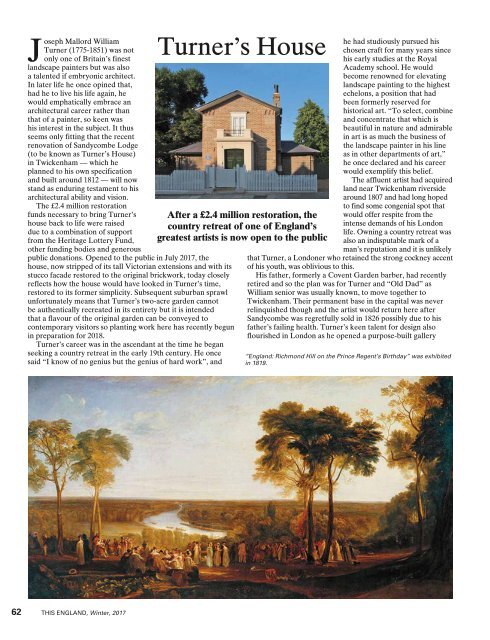This England
This England is the quarterly magazine for all who love our green and pleasant land and are unashamedly proud of their English roots. Published since 1968 the magazine has now become one of England’s best loved magazines and has a readership of over 115,000 people from around the world. As well as being popular in England it outsells all other British heritage magazines in Canada, Australia, New Zealand, South Africa and is sent to readers in every country of the world. Published in Cheltenham, in the heart of picturesque Gloucestershire, the magazine is edited, printed and despatched direct from England. Subscribe today and celebrate all that is best about England and the English way of life.
This England is the quarterly magazine for all who love our green and pleasant land and are unashamedly proud of their English roots. Published since 1968 the magazine has now become one of England’s best loved magazines and has a readership of over 115,000 people from around the world. As well as being popular in England it outsells all other British heritage magazines in Canada, Australia, New Zealand, South Africa and is sent to readers in every country of the world.
Published in Cheltenham, in the heart of picturesque Gloucestershire, the magazine is edited, printed and despatched direct from England. Subscribe today and celebrate all that is best about England and the English way of life.
You also want an ePaper? Increase the reach of your titles
YUMPU automatically turns print PDFs into web optimized ePapers that Google loves.
Joseph Mallord William<br />
Turner (1775-1851) was not<br />
only one of Britain’s finest<br />
landscape painters but was also<br />
a talented if embryonic architect.<br />
In later life he once opined that,<br />
had he to live his life again, he<br />
would emphatically embrace an<br />
architectural career rather than<br />
that of a painter, so keen was<br />
his interest in the subject. It thus<br />
seems only fitting that the recent<br />
renovation of Sandycombe Lodge<br />
(to be known as Turner’s House)<br />
in Twickenham — which he<br />
planned to his own specification<br />
and built around 1812 — will now<br />
stand as enduring testament to his<br />
architectural ability and vision.<br />
The £2.4 million restoration<br />
funds necessary to bring Turner’s<br />
house back to life were raised<br />
due to a combination of support<br />
from the Heritage Lottery Fund,<br />
other funding bodies and generous<br />
public donations. Opened to the public in July 2017, the<br />
house, now stripped of its tall Victorian extensions and with its<br />
stucco facade restored to the original brickwork, today closely<br />
reflects how the house would have looked in Turner’s time,<br />
restored to its former simplicity. Subsequent suburban sprawl<br />
unfortunately means that Turner’s two-acre garden cannot<br />
be authentically recreated in its entirety but it is intended<br />
that a flavour of the original garden can be conveyed to<br />
contemporary visitors so planting work here has recently begun<br />
in preparation for 2018.<br />
Turner’s career was in the ascendant at the time he began<br />
seeking a country retreat in the early 19th century. He once<br />
said “I know of no genius but the genius of hard work”, and<br />
Turner’s House<br />
After a £2.4 million restoration, the<br />
country retreat of one of <strong>England</strong>’s<br />
greatest artists is now open to the public<br />
he had studiously pursued his<br />
chosen craft for many years since<br />
his early studies at the Royal<br />
Academy school. He would<br />
become renowned for elevating<br />
landscape painting to the highest<br />
echelons, a position that had<br />
been formerly reserved for<br />
historical art. “To select, combine<br />
and concentrate that which is<br />
beautiful in nature and admirable<br />
in art is as much the business of<br />
the landscape painter in his line<br />
as in other departments of art,”<br />
he once declared and his career<br />
would exemplify this belief.<br />
The affluent artist had acquired<br />
land near Twickenham riverside<br />
around 1807 and had long hoped<br />
to find some congenial spot that<br />
would offer respite from the<br />
intense demands of his London<br />
life. Owning a country retreat was<br />
also an indisputable mark of a<br />
man’s reputation and it is unlikely<br />
that Turner, a Londoner who retained the strong cockney accent<br />
of his youth, was oblivious to this.<br />
His father, formerly a Covent Garden barber, had recently<br />
retired and so the plan was for Turner and “Old Dad” as<br />
William senior was usually known, to move together to<br />
Twickenham. Their permanent base in the capital was never<br />
relinquished though and the artist would return here after<br />
Sandycombe was regretfully sold in 1826 possibly due to his<br />
father’s failing health. Turner’s keen talent for design also<br />
flourished in London as he opened a purpose-built gallery<br />
“<strong>England</strong>: Richmond Hill on the Prince Regent’s Birthday” was exhibited<br />
in 1819.<br />
62 THIS ENGLAND, Winter, 2017
















